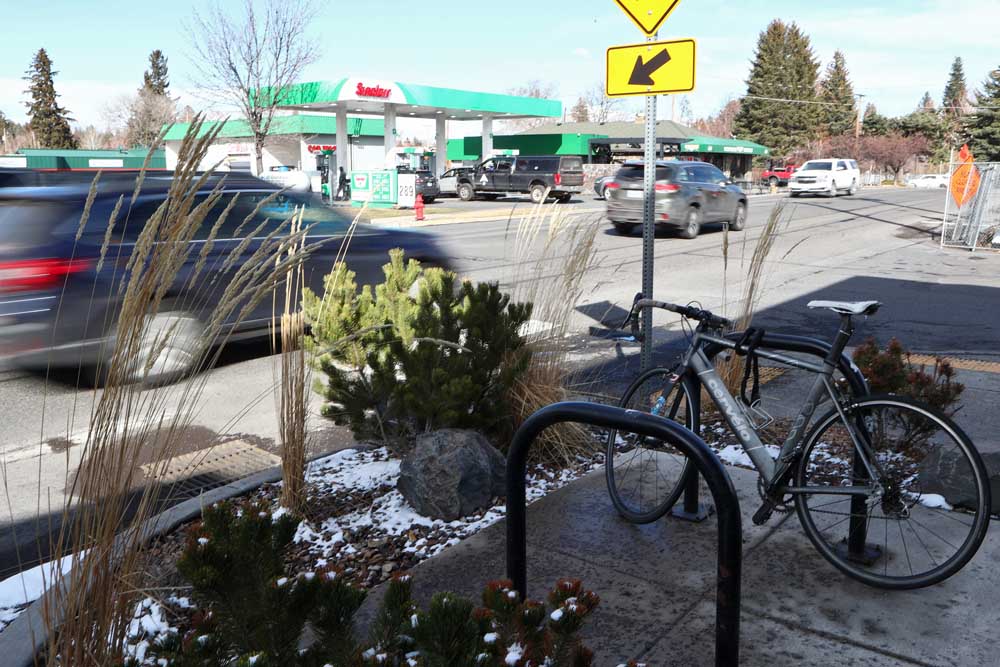City of Bend to implement transportation utility fee
Published 5:45 am Wednesday, March 29, 2023

- A bicycle is parked at a bike rack on NW Galveston Avenue in Bend on Friday.
The city of Bend will soon treat transportation like a utility, which means implementing a regular fee to fill a funding gap needed for the upkeep and improvement of Bend’s transportation system.
Sealing cracks in pavement, repairing roads or even improvements to bicycle and pedestrian pathways could be covered by the fee, which has been in the works for around five years and is still in the early stages of development.
Implementing the fee doesn’t require voter approval. It’s up to the City Council to approve the fee and its parameters based on public feedback. But the fee is a sure thing, Bend Mayor Melanie Kebler said during a March 15 City Council work session.
Residents could be paying a fee as soon as the end of this year, but, first, a holistic public outreach process must take place.
“We’re here because we’ve been kicking the can in this community for 15 years, and every second we wait, we’re just going to spend more money on this problem,” City Councilor Anthony Broadman said at the March 15 meeting.
Whether people in Bend are driving, walking, cycling or taking the bus, everyone benefits from a high quality transportation system, said Sarah Hutson, a senior policy analyst for the city.
“When we talk about treating transportation as a utility, it’s kind of thinking about how we all have impact on the transportation system. Even if you’re not driving, you still rely on transportation for the delivery of goods and things like that,” Hutson said.
How exactly the transportation utility fee will work is largely unclear. It will take at least three to six months before the City Council officially decides on a framework, Hutson said. Once fees begin to be collected, which could happen as soon as the end of the year, how the funds are used could be fairly broad, Hutson said.
“It really depends on the community you’re in, what ingredients will feel the most fair and what is the best fit,” she said.
A transportation utility fee in Oregon City is used only for road maintenance and improving road conditions. In Hillsboro, a transportation fee is used for the same, but it’s also used to bolster bicycle and pedestrian infrastructure.
Related story: ”City of Bend works toward bicycle and pedestrian infrastructure goals”
In Deschutes County, the majority of vehicle trips — 52% — are less than three miles, which presents a unique opportunity to turn those vehicle trips into walking or bicycle trips, said Robin Lewis, a transportation engineer for the city.
Outside of the transportation fee, the city of Bend is investing millions of dollars into bicycle and pedestrian infrastructure over the next 17 years as a part of its longterm transportation system plan. From revamping bike lanes on Wilson Avenue to creating safer crossings on Olney Avenue, the city is attempting to meet the demand for higher quality bicycle and pedestrian facilities.
Related story: ”City of Bend approves funds to improve bike, pedestrian safety at Olney Avenue”
Nearly 6% of workers in Bend bike or walk to work, according to 2021 data from the U.S. Census Bureau’s American Community Survey. Both modes of commuting have slightly increased in the past year, even as the number of employees working from home increased.
Overall, Bend is a fairly bike-friendly city. It received a silver rating from the League of American Bicyclists in 2021, but there was room for improvement. The state of Oregon as a whole ranked second on the league’s list of most bike-friendly states in the country, according to a 2022 report. However, the average percentage of people who bike to work in Bend, 3.4%, is above the state average, 1.8%.
The city is currently working on putting in signs throughout Bend to create a series of clear, connected routes for people to cycle on — easily navigated routs called wayfinding, said Russell Grayson, the chief operations officer for the city.
“We want to start with a really good backbone system that’s comfortable, and the goal of that is to tell people how to find it and how to follow it because right now people may not know,” Grayson said.
As the city tries to decide what is the best investment in its transportation system, the available funding creates a clear direction. The city doesn’t have the right capital to invest in widening roads and adding car lanes, said Grayson.
Congestion is bound to increase as Bend continues to grow, said Grayson
“That’s where alternative modes of transportation come in,” he said.
“It makes you think differently about how you may or may not want to move around town,” he said.






